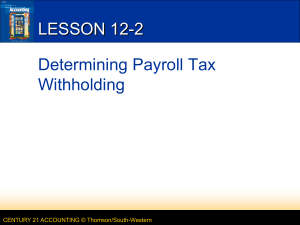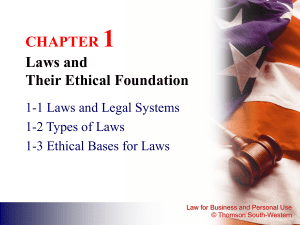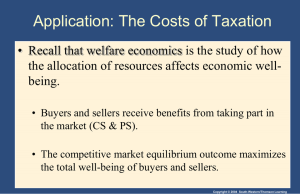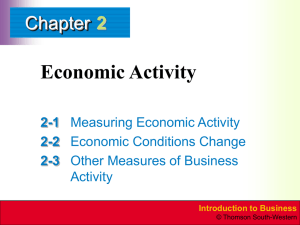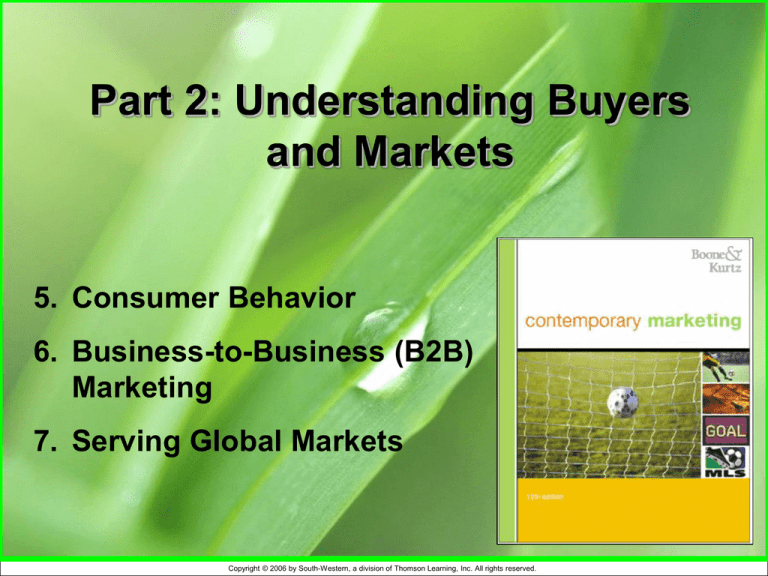
Part 2: Understanding Buyers
and Markets
5. Consumer Behavior
6. Business-to-Business (B2B)
Marketing
7. Serving Global Markets
Copyright © 2006 by South-Western, a division of Thomson Learning, Inc. All rights reserved.
Chapter 5
Consumer
Behavior
Copyright © 2006 by South-Western, a division of Thomson Learning, Inc. All rights reserved.
Chapter Objectives
1. Distinguish between customer behavior and
consumer behavior.
2. Explain how marketers classify behavioral influences
on consumer decisions.
3. Describe cultural, group, and family influences on
consumer behavior.
4. Explain each of the personal determinants of
consumer behavior; needs and motives, perceptions,
attitudes, and self-concept theory.
5. Distinguish between high-involvement and lowinvolvement purchase decisions.
6. Outline the steps in the consumer decision process.
7. Differentiate among routinized response behavior,
limited problem solving, and extended problem
solving by consumers.
Copyright © 2006 by South-Western, a division of Thomson Learning, Inc. All rights reserved.
5-3
Customer vs. Consumer Behavior
Customer behavior: a broad term that
covers both individual consumers who buy
goods and services for their own use and
organizational buyers who purchase
business products
Consumer behavior: the process through
which the ultimate buyer makes purchase
decisions
Copyright © 2006 by South-Western, a division of Thomson Learning, Inc. All rights reserved.
5-4
Interpersonal Determinants of
Consumer Behavior
Figure 5.1: Why People Buy New Products
Copyright © 2006 by South-Western, a division of Thomson Learning, Inc. All rights reserved.
5-5
Cultural Influences
Culture: values, beliefs, preferences, and
tastes handed down from one generation to
the next
It is important to recognize the concept of
ethnocentrism, or the tendency to view
your own culture as the norm, as it relates
to consumer behavior.
Copyright © 2006 by South-Western, a division of Thomson Learning, Inc. All rights reserved.
5-6
Core Values in the U.S. Culture
While some cultural values change over
time, basic core values do not
Examples of American core values
include:
Importance of family and home life
Education
Youthfulness
Individualism
Copyright © 2006 by South-Western, a division of Thomson Learning, Inc. All rights reserved.
5-7
International Perspective on Cultural
Influences
Cultural differences are particularly important
for international marketers
Successful strategies in one country often
cannot extend to other international markets
because of cultural variations
Copyright © 2006 by South-Western, a division of Thomson Learning, Inc. All rights reserved.
5-8
Subcultures: subgroup of culture with its
own, distinct modes of behavior
Cultures are not homogeneous entities with
universal values.
Subcultures can differ by:
Ethnicity or Nationality
Age or Gender
Religion
Social class or Profession
Figure 5.2 (next slide)
Ethnic and Racial Minorities as a
Percentage of the Total U.S. Population
Copyright © 2006 by South-Western, a division of Thomson Learning, Inc. All rights reserved.
5-9
Copyright © 2006 by South-Western, a division of Thomson Learning, Inc. All rights reserved.
5-10
Hispanic-American Consumers
The 40 million Hispanics in the U.S., coming
from a wide range of countries, are not
homogenous
There are important differences in
acculturation
The Hispanic market is large and fastgrowing
Hispanics tend to be younger than the
general U.S. population
Hispanics are geographically concentrated
Copyright © 2006 by South-Western, a division of Thomson Learning, Inc. All rights reserved.
5-11
African-American Consumers
African-American buying power is rising
rapidly compared to U.S. consumers in
general
Family structures may differ for AfricanAmerican consumers, creating differences
in preferences for clothing, music, cars,
and many other products
Copyright © 2006 by South-Western, a division of Thomson Learning, Inc. All rights reserved.
5-12
Asian-American Consumers
Marketing to Asian-Americans presents
many of the same challenges as reaching
Hispanics
Asian-Americans are spread among
culturally diverse groups, including
Chinese, Japanese, Indians, Koreans,
Filipinos, and Vietnamese--many retaining
their own languages
Copyright © 2006 by South-Western, a division of Thomson Learning, Inc. All rights reserved.
5-13
Social Influences
Group membership influences an individual’s
purchase decisions and behavior in both
overt and subtle ways.
Norms: are the values, attitudes, and
behaviors that a group deems appropriate
for its members
Status: is the relative position of any
individual member in a group
Roles define behavior that members of a
group expect of individuals who hold
specific positions within the group
Copyright © 2006 by South-Western, a division of Thomson Learning, Inc. All rights reserved.
5-14
The Asch Phenomenon: the effect of a
reference group on individual decision-making
Reference groups: groups whose value
structures and standards influence a person’s
behavior
Requires two conditions:
The purchased product must be one that
others can see and identify
The purchased item must be
conspicuous; it must stand out as
something unusual, a brand or product
that not everyone owns
Copyright © 2006 by South-Western, a division of Thomson Learning, Inc. All rights reserved.
5-15
Social classes: groups whose rankings are
determined by occupation, income,
education, family background, and residence
location
W. Lloyd Warner identified
six classes:
1. Upper-upper
2. Lower-upper
3. Upper-middle
4. Lower-middle
5. Working class
6. Lower class
Copyright © 2006 by South-Western, a division of Thomson Learning, Inc. All rights reserved.
5-16
Opinion leaders:
trendsetters who
purchase new
products before
others in a group
and then
influence others
in their purchases
Figure 5.4:
Alternative
Channels for
Communications
Flow
Copyright © 2006 by South-Western, a division of Thomson Learning, Inc. All rights reserved.
5-17
Family Influences
Autonomic role is when the partners
independently make equal numbers of
decisions.
Husband-dominant role is when the
husband makes most of the decisions.
Wife-dominant role is when the wife makes
most of the decisions.
Syncratic role is when both partners jointly
make most decisions.
Copyright © 2006 by South-Western, a division of Thomson Learning, Inc. All rights reserved.
5-18
Children and Teenagers in Family
Purchases
Growing numbers are assuming
responsibility for family shopping
They also influence what parents buy
They represent over 50 million
consumers in their own right
Copyright © 2006 by South-Western, a division of Thomson Learning, Inc. All rights reserved.
5-19
Personal Determinants of
Consumer Behavior
Copyright © 2006 by South-Western, a division of Thomson Learning, Inc. All rights reserved.
5-20
Needs and Motives
Need: an imbalance between a consumer’s
actual and desired states
Motives: inner states that direct a person
toward the goal of satisfying a felt need
Copyright © 2006 by South-Western, a division of Thomson Learning, Inc. All rights reserved.
5-21
Maslow’s Hierarchy of Needs
Self-Actualization
Esteem Needs
Social Needs
Safety Needs
Physiological Needs
Copyright © 2006 by South-Western, a division of Thomson Learning, Inc. All rights reserved.
5-22
Physiological Needs
Products
Vitamins, herbal supplements, medicines, food, exercise
equipment, fitness clubs
Marketing
themes
Pepcid antacid—”Just one and hearburn’s done”
Puffs facial tissues—”A nose in need deserves Puffs indeed”
Ocean Spray cranberry juice—”Crave the wave”
Safety Needs
Products
Cars and car accessories, burglar alarm systems, retirement
investments, insurance, smoke and carbon-monoxide detectors,
medicines
Marketing
themes
Fireman’s Fund insurance—“License to get on with it.”
American General Financial Group—“Live the life you’ve imagined.”
Volvo—“Protect the body. Ignite the soul.”
Copyright © 2006 by South-Western, a division of Thomson Learning, Inc. All rights reserved.
5-23
Belongingness
Products
Beauty aids, entertainment, clothing, cars
Marketing
themes
Old Navy—”Spring Break from coast to coast”
Washington Mutual banks—”More human interest”
TJ Maxx clothing store—”You should go”
Esteem Needs
Product
Clothing, cars, jewelry, hobbies, beauty spa services
Marketing
themes
Lexus automobiles—The relentless pursuit of perfection”
Van Cleef & Arpels—“The pleasure of perfection.”
Accutron watches—“Perhaps it’s worthy of your trust.”
Jenn-Air kitchen appliances—“The sign of a great cook.”
Self-Actualization
Products
Education, cultural events, sports, hobbies, luxury goods,
technology, travel
Marketing
themes
Gatorade—“Is it in you?”
DePaul University—”Turning goals into accomplishments”
Dodge cars and trucks—”Grab life by the horns”
Copyright © 2006 by South-Western, a division of Thomson Learning, Inc. All rights reserved.
5-24
Perceptions: the meaning that a person
attributes to incoming stimuli gathered
through the five senses – sight, hearing,
touch, taste, and smell.
Perceptual screens: the filtering
processes through which all inputs must
pass
Copyright © 2006 by South-Western, a division of Thomson Learning, Inc. All rights reserved.
5-25
Subliminal Perception: subconscious receipt
of information
Almost 50 years ago, a New Jersey movie
theater tried to boost concession sales by
flashing the words Eat Popcorn and Drink
Coca-Cola.
Subliminal advertising is aimed at the
subconscious level of awareness.
Subliminal advertising has been universally
condemned as manipulative, and is
exceedingly unlikely that it can induce
purchasing.
Research has shown that subliminal
messages cannot force receivers to purchase
goods that they would not consciously want.
Copyright © 2006 by South-Western, a division of Thomson Learning, Inc. All rights reserved.
5-26
Attitudes
A person’s enduring favorable or
unfavorable evaluations, emotional feelings,
or action tendencies toward some object or
idea
Attitude components:
Cognitive
Affective
Behavioral
Copyright © 2006 by South-Western, a division of Thomson Learning, Inc. All rights reserved.
5-27
Changing Consumer Attitudes
Attempt to produce consumer attitudes that
will motivate the purchase of a particular
product
Evaluate existing consumer attitudes and
then make the product characteristics appeal
to them
Modifying the Components of Attitude
Attitudes change in response to
inconsistencies among the three components
Marketers can work to modify attitudes by
providing evidence of product benefits and
by correcting misconceptions
Copyright © 2006 by South-Western, a division of Thomson Learning, Inc. All rights reserved.
5-28
Learning
An immediate or expected change in
behavior as a result of experience.
The learning process includes the
component of:
Drive
Cue
Response
Reinforcement
Copyright © 2006 by South-Western, a division of Thomson Learning, Inc. All rights reserved.
5-29
Applying Learning Theory to Marketing
Decisions
Shaping: process of applying a series of
rewards and reinforcements to permit
more complex behavior to evolve over
time
Copyright © 2006 by South-Western, a division of Thomson Learning, Inc. All rights reserved.
5-30
Self-Concept
A person’s multifaceted picture of himself or
herself, composed of the:
Real self
Self-image
Looking-glass self
Ideal self
Copyright © 2006 by South-Western, a division of Thomson Learning, Inc. All rights reserved.
5-31
The Consumer Decision Process
Problem
Opportunity
Recognition
Search
Alternative
Evaluation
Purchase
Decision
Consumers complete a step-by-step
process when making purchase
decisions
High-involvement purchase
decisions are those with high levels
of potential social or economic
consequences
Low-involvement decisions are
routine purchases that pose little
risk to the consumer
Purchase
Act
Postpurchase
Evaluation
Copyright © 2006 by South-Western, a division of Thomson Learning, Inc. All rights reserved.
5-32
Figure 5.8
Integrated Model
of the Consumer
Decision Process
Copyright © 2006 by South-Western, a division of Thomson Learning, Inc. All rights reserved.
5-33
Problem or Opportunity Recognition
Consumer becomes aware of a
significant discrepancy between the
existing situation and the desired
situation
Motivates the individual to achieve the
desired state of affairs
Copyright © 2006 by South-Western, a division of Thomson Learning, Inc. All rights reserved.
5-34
Search
Consumer gathers information related to
their attainment of the desired state of affairs
Identifies alternative means of problem
solution
May cover internal or external sources of
information
Brands that a consumer actually considers
buying before making a purchase decision
are known as the evoked set
Copyright © 2006 by South-Western, a division of Thomson Learning, Inc. All rights reserved.
5-35
Evoked Set
Model
All
Brands
Known
Brands
Evoked
Acceptable
Set
Brands
Purchased
Brand
Unknown
Brands
Unacceptable
Brands
Rejected
Brands
Overlooked
Brands
Inert
Set
Copyright © 2006 by South-Western, a division of Thomson Learning, Inc. All rights reserved.
5-36
Evaluation of Alternatives
Consumer evaluates the evoked set
Difficult to completely separate the second
and third steps, since some evaluation
takes place as the search progresses
Outcome of the evaluation stage is the
choice of a brand or product (or possibly a
decision to renew the search)
Evaluative criteria: features that a
consumer considers in choosing among
alternatives
Copyright © 2006 by South-Western, a division of Thomson Learning, Inc. All rights reserved.
5-37
Purchase Decision and Purchase Act
Consumer narrows the alternatives
down to one
The purchase location is decided
Copyright © 2006 by South-Western, a division of Thomson Learning, Inc. All rights reserved.
5-38
Postpurchase Evaluation
After the purchase, consumers are either
satisfied or experience post-purchase
anxiety
Cognitive dissonance: Post-purchase
anxiety that results from an imbalance
among an individual’s knowledge, beliefs,
and attitudes after an action or decision is
taken
Copyright © 2006 by South-Western, a division of Thomson Learning, Inc. All rights reserved.
5-39
Classifying Consumer Problem-Solving
Processes
Three categories of problem-solving
behavior
Routinized Response Behavior
Limited Problem Solving
Extended Problem Solving
Copyright © 2006 by South-Western, a division of Thomson Learning, Inc. All rights reserved.
5-40




